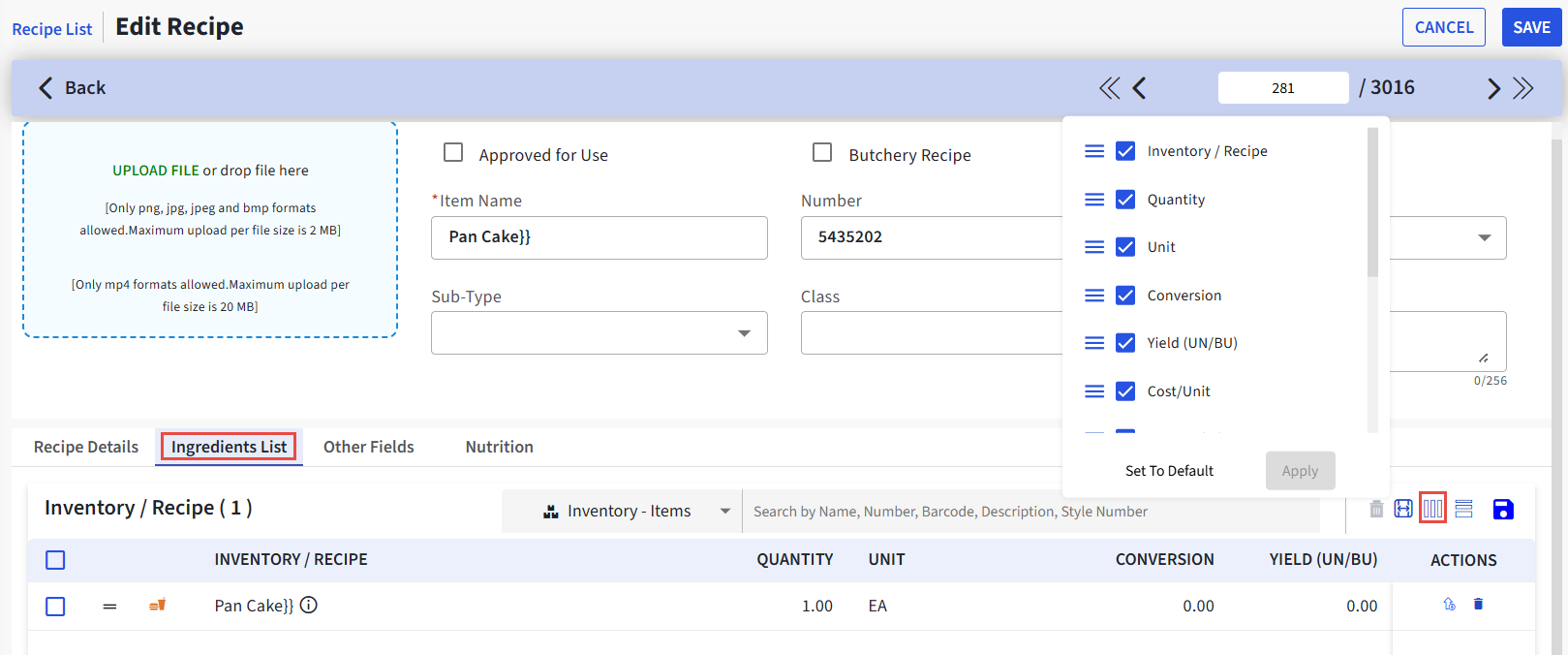Managing Recipe
Eatec allows the users to define, analyze and manage the recipes under this section.
Recipes can be managed under the following categories:
-
Define Product
-
Define Finished Goods
-
Manage Package
-
Approve Nutrition
-
Inventory List
-
Analysis
-
Print Nutrition
Define Product
The Define Product section allows a user to edit a recipe. Users can perform the following steps to edit a recipe:
Click Masters ➜ Recipe ➜ Manage.
Click Manage ➜ Define Product. The New Product- F&B page appears.
Refer to the following table and fill in the fields:
|
Field |
Description |
|---|---|
|
Name |
The name of the retail product. |
|
Image |
The display image of the retail product. |
|
Number |
The system generated identification number of the product. |
|
Description |
The description of the product. |
|
Unit |
The unit of the product. |
|
Type |
The type to which the product belongs. |
|
Sub Type |
The sub type to which the product belongs. |
|
Class |
The class to which the product is grouped. |
|
Alternate Id |
The alternate identification number of the product. |
Click Save.
Define Finished Goods
Define Finished Goods allows users to create a finished goods inventory item with prefix FG. For example, if the user tries to define finished good for an Apple Pie recipe item, then it automatically converts as FG Apple Pie.
Users can perform the following steps to create a finished good:
Click Masters ➜ Recipes ➜ Manage. The Manage drop-down appears.
Click Manage ➜ Define Product. The New Product- F&B page appears.
Refer to the following table and fill in the fields:
|
Field |
Description |
|---|---|
|
Image |
The display image of the retail product. |
|
Name |
The name of the retail product. |
|
Number |
The system generated identification number of the product. |
|
Barcode |
The barcode of the product. |
|
Type |
The type to which the product belongs. |
|
Sub Type |
The sub type to which the product belongs. |
|
Class |
The class to which the product is grouped. |
|
Hazmat |
Field that indicates the presence of hazardous materials in the inventory item. Users can choose to enable this checkbox while creating/modifying an F&B inventory item. |
|
Description |
The description of the product. |
Click Save.
Users are allowed to add/update the user-entered ingredients to finished goods nutrition data.
By default, if an FG item does not have any linked production recipe, then the User-entered Ingredients field remains empty.
If the FG item is linked to a production recipe and the recipe contains the user-entered ingredients, then the same data is cascaded from the linked recipe to the current FG item nutrition user-entered ingredients section.
Users must ensure to perform the following while entering the ingredients:
-
Arrange the user-entered ingredients data from the linked items based on grams contributed from the recipe and seed into the FG inventory nutrition.
The nutrition data is saved at the product nutrition level only when the Lock nutrition when item linked checkbox is enabled under Setup ➜ System Preference ➜ Inventory Options.
Click on the Nutrition tab.
Refer to the following table and fill in the fields:
|
Field |
Description |
|---|---|
|
USDA Nutrition Link |
|
|
USDA Item |
The name of the USDA item. Eatec displays the complete nutrition name in the USDA Item popup. Data is collected on the following nutrients:
|
|
Product Serving Service/Nutrition Calculator |
|
|
Grams per Serving |
The number of grams in per serving of the item. For example, a product with each serving having 62 grams. |
|
Serving per Base Unit |
The number of units in base unit. For example, a case that holds 24 units of a product, with each unit 62 grams. Here, 24 is the serving per base unit. |
|
/BU |
The Grams per Serving is multiplied by the Servings per Base Unit to calculate the proper conversion between the entered grams and the defined base unit. For example, an inventory item is defined with a base unit equal to a Case. This case holds 24 units of the product, each unit is 62 grams. The user enters 62 in the Grams per Serving field and 24 in the Servings per Base Unit field. Using this information, Eatec automatically performs the calculation for the conversion and displays it in this field. |
|
Label Information |
|
|
Allergens |
Indicates any allergens that are present in the recipe. For example, Egg |
|
Ingredients |
Lists all ingredients in a recipe. |
|
User-entered ingredients |
The ingredients entered by the user. Users can add or update the user-entered ingredients value in the nutrition data. For example, Dark Chocolate (76.2%), Sugar, Cocoa solids (28.2%) |
|
Refuse Adjustments |
|
|
Refuse % |
Indicates the percentage of a form of yield for an inventory item or recipe to calculate nutritional information and gram weight of a recipe or product more accurately. In this field:
The use of plastic cutlery or packaging in a recipe. Set these items with a refuse % of 100 so that they are not considered in the nutritional calculation. |
|
Nutrients |
|
|
Nutrient |
The name of the nutrient and the unit expressed. For example, Calories (kcal), Cholesterol (g), Vitamin C (mg) |
|
% |
The daily recommended value in percentage. |
|
/NaN gms |
The grams per serving. |
|
/100 gms |
Standard 100 grams per serving. |
Click Save.
Replace Recipe Item
Recipe Replace Item is applicable to the following functions in Eatec:
-
Linked items in Products
-
Linked items in Recipes
-
Recipes in Packages
-
Production Recipes in FG inventory items
-
Nutrition cascade to replaced entities
-
Revision of cost for selected entities
Perform the following steps to replace the recipe item with the current item:
Click Masters ➜ Recipes.
Select the recipe to be replaced.
Click Manage ➜ Replace Recipe Item. The Replace Recipe Item pop-up appears.
Refer to the following table and fill in the fields:
|
Field |
Description |
|---|---|
|
Replace With |
Enter 2 or more letters of the item to be replaced. Select the preferred item. |
|
Conversion |
The conversion factor between the batch unit of selected recipe and current recipe. |
|
Units |
Displays the batch unit of the recipe. The value is auto populated and read-only. |
|
Replace In |
Select the preferred option from the drop-down list. |
|
Affected Items |
Displays the affected items. The values appear based on the option selected from the Replace In drop-down list. |
Click Replace to replace the recipe item with the current item.
Formula for Replacing Recipe in Recipe/Product links
-
Conversion from Units Conversion: Conversion factor between combination of New Recipe Batch Unit (as From unit) and Old Recipe Batch Unit (as To unit)
-
New Link item Qty = As same as old link item quantity (no change)
-
New Link item conversion = User provided conversion for new recipe × existing link item conversion of the old recipe
-
New Link Item Yield = 1/Conversion factor of New Recipe
-
New Link Item Unit = Existing Link Unit
-
New Link Item Cost = Conversion × New Recipe Batch Cost/Unit
-
New Link Item Amount = Quantity × Cost
Manage Package
Eatec allows the users to manage the recipe packages under this section.
Users can manage packages by performing the following steps:
Click Manage ➜ Manage Packages. The Manage Packages page appears with the following details:
-
Package name
-
Barcode number
-
List of packages
Select the preferred items to add to the package.
Click Save.
Users can search for the preferred package by entering the package name in the Search text box.
Creating New Packages
Users can create new packages by performing the following steps:
Click Manage ➜ Manage Package.
Click Create New Packages. The Manage Packages pop-up appears.
Refer to the following table and fill in the fields:
|
Field |
Description |
|---|---|
|
Name |
The name of the package. |
|
Description |
The description about the package. |
Click Save.
Inventory Items
Users can access the details of the inventory items under this section. Users can view the inventory item details by performing the following steps:
Click Manage ➜ Inventory Items. The Inventory Items page appears with the details of the Inventory Items/Recipes.
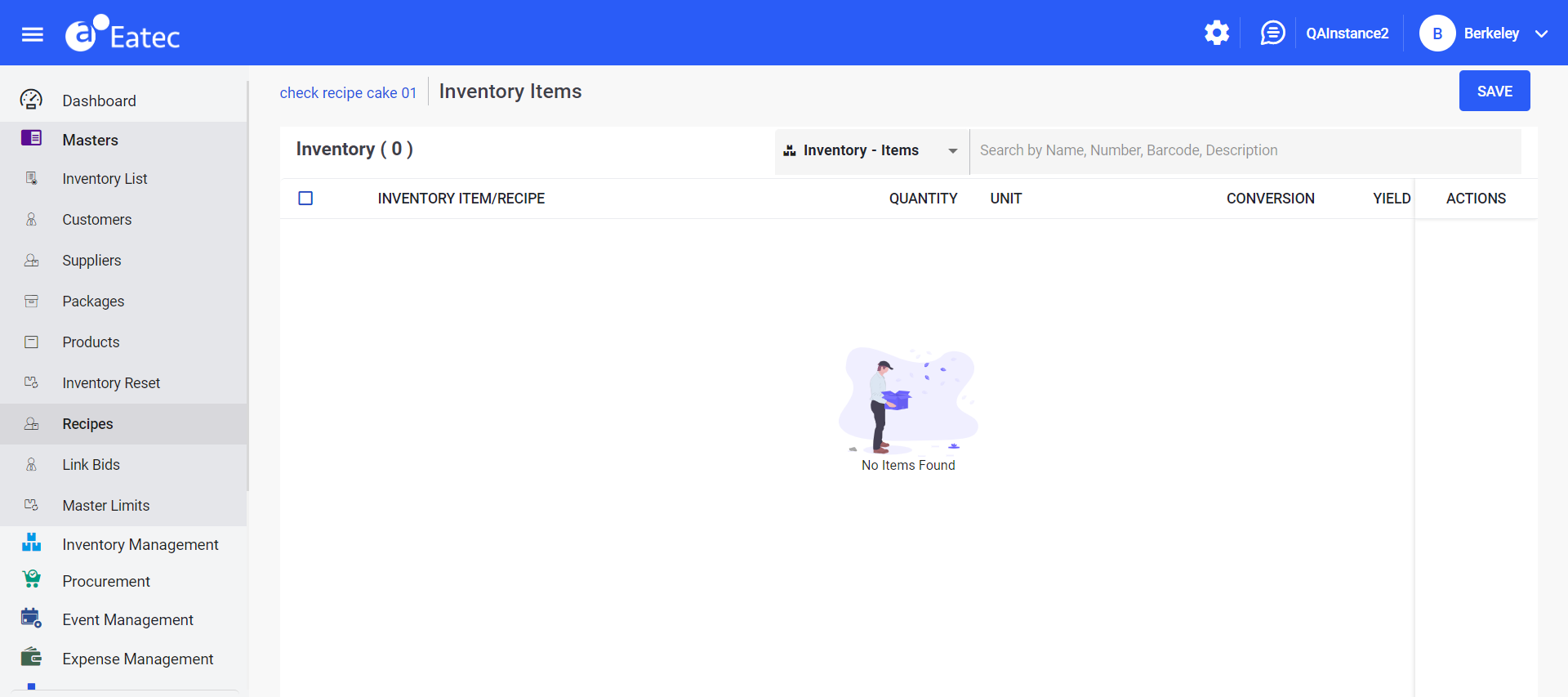
Click on the amount under Quantity and change the amount as preferred.
Click Save.
Users can modify the unit section by performing the same steps on the Unit section.
Users can also delete a recipe by performing the following steps:
Click Manage ➜ Inventory Items. The Inventory Items page appears with the details of the Inventory Items/ Recipes.
Click Menus under the Actions tab. The Delete option is displayed.

Click Delete.
Displaying All Units of Measure in Recipes
The Recipe module in Eatec is enhanced to display all active units of measure when an inventory item or recipe is linked to another recipe. Earlier, only four units were listed that were defined at the ingredient setup. Users can now select or add any unit of measure to add ingredients or recipes to a recipe.
All units are commonly listed for both inventory and recipe linkages. Any new unit that is linked to the item/recipe at the linkage level is considered as the recipe unit (RU) type.
This enhancement is applicable to the following Inventory and Recipes types:
-
Items
-
Packages
-
Class
-
Type
To view all units of measure, users can navigate to the following path:
Click Masters ➜ Recipes.
Select a recipe.
Click Create New or Edit.
Select the Ingredients List tab. The Inventory /Recipe section appears.

Search and select the ingredient to be added in the Search by Name, Number, Barcode, Description search text box.

Click Select. The Added FG Products pop-up appears.
Click Add. The ingredients/recipe is added.

Click the drop-down under the Unit column to see all active units of measure.
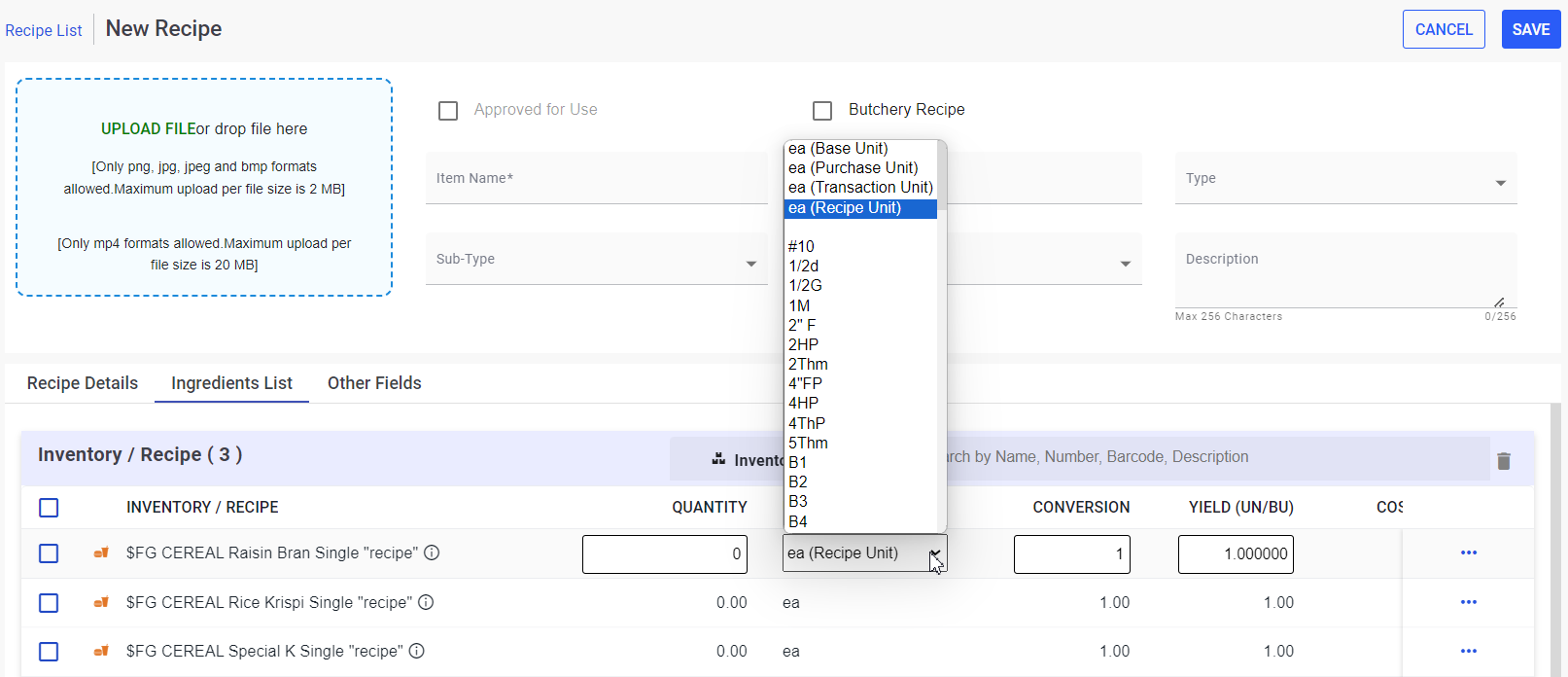
Select the preferred unit from the Unit drop-down menu.
Click Save.
The Conversion and Yield fields in Recipes are inversed if an undefined unit of measure (UOM) is selected for an item.
Approve Nutrition
Eatec allows users with approval permission to approve a recipe’s nutrition. Users with this permission can access the Unapproved Nutrition (RcpNut-Unapproved) report. This report contains a list of recipes modified by the users in such a way that the nutrition of the recipe was altered. Any changes made to the recipe that alters its nutrition must be approved by the nutrition approver.
When nutrients of a recipe are altered due to the changes made to it, the Nutrients section displays the Unapproved status under the Nutrition tab of the recipe profile.
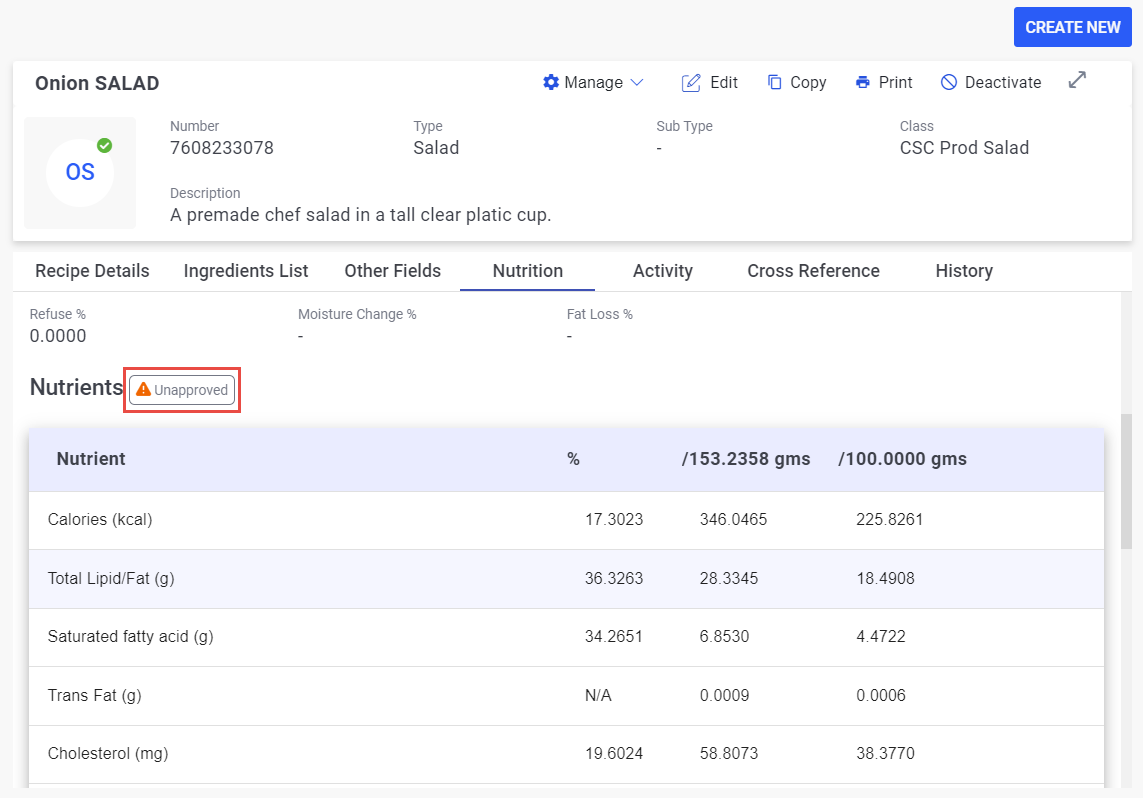
Users with nutrition approval rights are provided with the Approve Nutrition option under the Manage settings of the recipe profile in the Recipes module.

Once approved by the nutrition approver, the status of the Nutrients section changes to Approved under the Nutrition tab of the recipe profile.
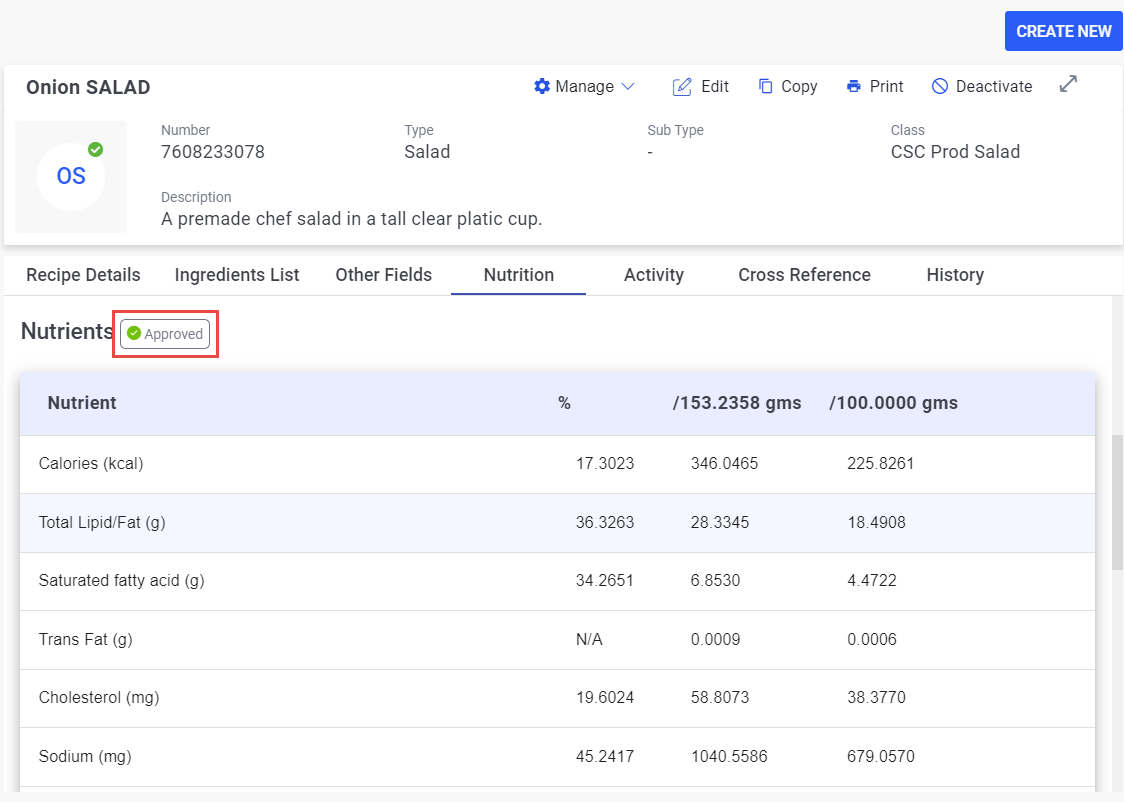
All changes made are tracked in the History tab of the recipe profile.
Eatec supports the Unapproved Nutrition (RcpNut-Unapproved) under the Reports module to display the list of recipes modified by the users in such a way that the nutrition of the recipe was altered.
Go to Report ➜ Report to open the New Report page.
Select the Recipes category.
Select Database from the Selection field drop-down.
Select the Unapproved Nutrition (RcpNut-Unapproved) report from the Reports field drop-down.
Enter the following details under Filters ➜ Filter:
-
Recipe Types
-
Classes
-
Recipe
-
User Types
-
Recipe Packages
Exclude any filters by selecting the checkbox if preferred.
Click Generate Report to generate the report and view the same under View Report.
Click Download to download the report in the following formats:
-
PDF document (.pdf)
-
Excel document (.xlsx)
-
Word document (.docx)
-
Web Page (.html)
Unapproved Nutrition Report

The provision that allows Eatec to support the unapproved nutrition report is available in the Eatec Enterprise Management Portal.
Log on to the Eatec Enterprise Management Portal.
Click All Enterprises. The Enterprises page appears with the All Enterprises list.
Select the Settings icon corresponding to the preferred enterprise for which the unapproved nutrition report must be supported. The Enterprise Configuration pop-up window appears.
Select CustomFeatures from the Configuration Group drop-down field.
Select NutritionApproval from the Configuration Key drop-down field.
Set the Configuration Value to True.
Click Save.
Users must enable the IsRecipeNutritionAdmin checkbox under Users ➜ Users ➜ Edit User page in the Setup module.
Analysis
Users can analyze the details of the inventory items under in this section by performing the following steps:
Click Masters ➜ Recipe. The Recipes page appears.
Click Manage ➜ Analysis. The Analysis page appears with the following tabs:
-
Inventory Items - detailed analysis of the inventory items.
-
Shopping Cart - list of items in the shopping cart.
Recipe - Analysis - Scaling
-
Users can scale sub-recipes & inventory items linked to Recipe from Recipe ➜ Manage ➜ Analysis
-
Scaling can be applied to recipe using Makes, Multiply & Scale %
-
Effect of scaling shall be applied based on scale mode linked to ingredients of recipe.
Inventory Items
Users view the detailed analysis of inventory items under this section and print or download the item analysis.
Click Manage ➜ Analysis ➜ Inventory Items. The Analysis page appears with the following details:

|
Field |
Description |
|---|---|
|
Item/Recipe |
The list of items/recipe that is added in the inventory list. |
|
Quantity Required |
The total number of quantity required for the item. |
|
Quantity On Hand |
The available quantity of item. The count (in base units) of the current global inventory based on the most recent transactions and postings. |
|
Quantity On Req |
The global count (in base units) of the total quantity of an item that is on requisition. |
|
Quantity On Order |
The global count (in base units) of inventory items due to arrival, based on outstanding purchase orders. Eatec increases Quantity on Hand (QOH) and decreases Quantity on Order (QOO) at the time of merchandise arrival. |
|
Quantity |
The total quantity of the item. |
|
Unit |
The base unit of the item. |
|
Cost/Unit |
The cost of the item per unit. |
|
Amount |
The amount of the item. |
|
Supplier |
The name of supplier. |
Print Worksheet
Perform the following steps to print or download the item analysis:
Click Print Worksheet. The PDF of the item analysis is downloaded.
Scaling
Scaling allows users to scale the quantity of the products listed in the Analysis section.
Click Scaling on the top right-hand side of the Analysis ➜ page. The Scaling pop-up appears.
Refer to the following table and fill in the fields:
|
Field |
Description |
|---|---|
|
Makes |
The value gets multiplied with the quantity of the product as displayed in the Analysis section. By default, the value is 1.00. |
|
Multiply By |
The value gets multiplied with the quantity of the product as displayed in the Analysis section. |
|
Scale By (%) |
The sales quantity is scaled up/down with respect to the percentage provided here. When user confirms the scaling data, the scaling effect alters the data in the table displayed in the Analysis section. |
|
Round Up |
The scaled quantity values are rounded off to the next nearest natural number. For example, 4.34 is rounded off as 5.00. |
Click Update.
Recipe - Ingredients List - Scaling Mode
-
Scale mode shall be dedicated column provided in section Create / Edit Recipe ➜ Ingredient List ➜ Table of Ing. list
-
Scale Mode shall be,
-
Normal - When scaling is applied over the selected recipe, then ingredient with Scale Mode. Normal, shall also be scaled along with linked master recipe
-
Don't Scale - When scaling is applied over the selected recipe, then ingredient with Scale Mode. Don't Scale, shall NOT be scaled along with linked master recipe
-
Round Up - When scaling is applied over the selected recipe, then ingredient with Scale Mode. Round up, shall also be scaled & resulting scale QTY shall be rounded up to next whole number (no fractions or decimals are expected)
-
Round Down - When scaling is applied over the selected recipe, then ingredient with Scale Mode. Round down, shall also be scaled & resulting scale QTY shall be rounded up to previous whole number (no fractions or decimals are expected).
-
Recipe - Manage - Scale
-
Users shall be provided with option to SCALE recipes using Batch Size Quantity of Recipe
-
Option to scale recipe shall be provided at Recipe ➜ (Select a recipe to scale) ➜ Mange ➜ Scale
-
System shall open a popup screen to get desired (scaled) recipe batch size QTY
-
Popup Fields & Actions:
-
Heading Scale: <Recipe Name>
-
Field Name: Batch Size Quantity
-
Field Type: Numeric only field
-
Default: selected recipe's batch size quantity
-
Validations:
-
Max. Length: 17 (10 whole number, 1 decimal point & 6 decimal numbers)
-
Min. Value: greater than 0.000001
-
-
-
Actions: Confirm
-
Eatec system scales the recipe batch QTY to provided QTY
-
Scale recipe's ingredient items to Linked QTY as below,
-
Scale Factor = new Batch Size QTY / old Batch Size QTY
-
New Ingredient Link QTY = old ingredient link QTY × scale factor
-
Ingredients shall be scaled based on SCALE MODEs mentioned for each recipe ingredient item.
-
Recipe is saved with scaled batch size QTY and ingredient link QTYs
-
Cancel: Eatec system shall not scale and close Scale popup. Users are directed to the view screen of the selected recipe.
-
Print Worksheet
It shows the quantities of all recipes that require preparation, as well as the quantities of ingredients and sub-recipes for each recipe. Users can print worksheets for a single recipe, menu, or product, or for an entire sale plan.
Users are provided with multiple worksheet forms from which they can select a preferred form. Once the preferred worksheet is selected, Eatec migrates the data from the sales plan and integrates with the fields in selected form. The .rpt file format worksheet is converted into a .pdf file.
Perform the following steps to print or download the item analysis:
Click Print Worksheet that appears on the top right-hand side of the Analysis page. The Print Worksheet pop-up appears.
Enable the following checkboxes:
-
Expanded List
-
Recipe Compilation
Select the preferred form from the Form drop-down list:
-
Standard Work Form
-
Master Recipes Scaled
-
All Recipes Scaled
-
Recipe Summary
-
Finished Goods Summary
Click Print. The PDF opens in a web browser.
Sample Print Worksheet
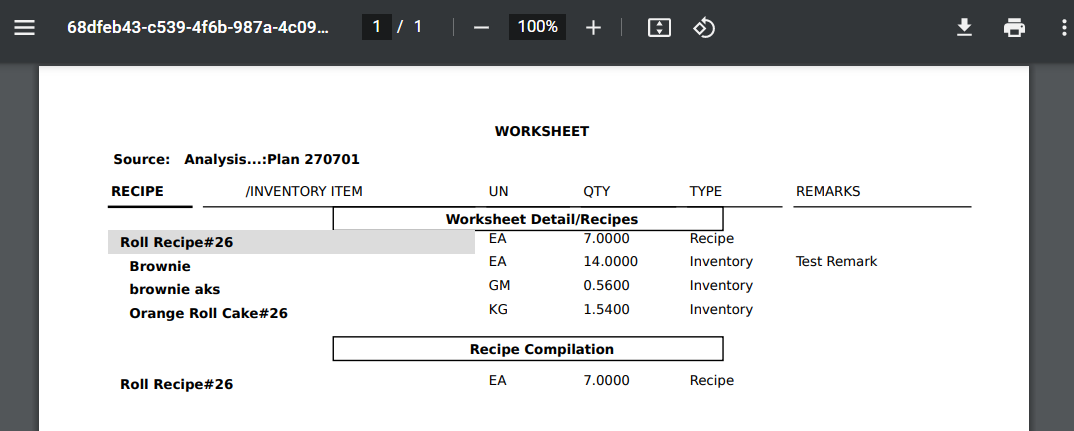
Click the Print option from the PDF. The print setup appears.
Select the preferred destination.
Click Print.
Shopping Cart
This tab includes the list of inventory items to be purchased.
Click Manage ➜ Analysis ➜ Shopping Cart. The Saved List section appears with the list of saved items.

Perform the following steps to create a new inventory item list:
Click Manage ➜ Analysis ➜ Shopping Cart.
Click Create New List. The following pop-up appears.
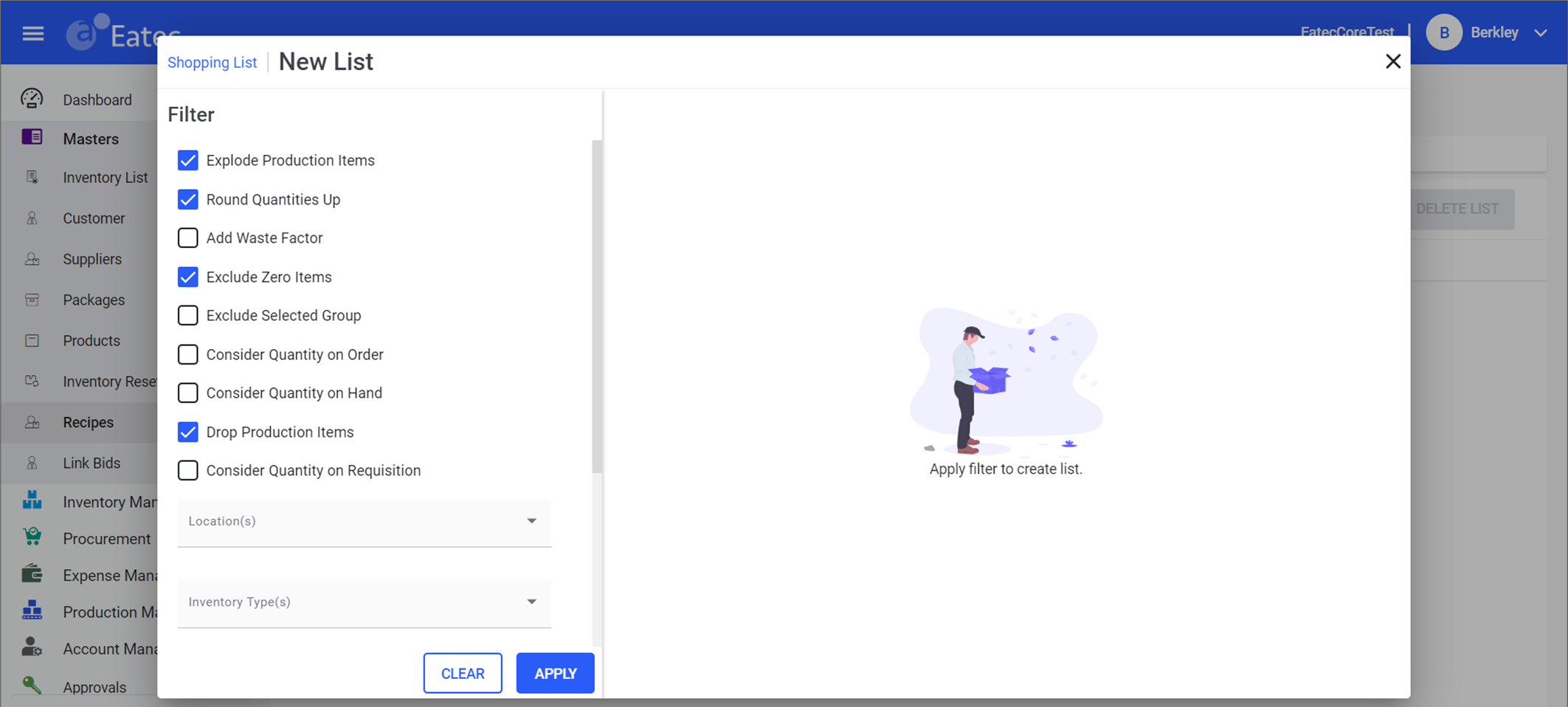
Select or multiselect the preferred checkbox corresponding to the following options:
-
Explode Production Items
-
Round Quantities Up
-
Add Waster Factor
-
Exclude Zero Items
-
Exclude Selected Group
-
Consider Quantity on Order
-
Consider Quantity on Hand
-
Drop Production Items
-
Consider Quantity on Requisition
Based on the selected checkboxes the inventory items list is saved.
Refer to the following table and fill in the fields:
|
Field |
Description |
|---|---|
|
Locations |
Select a location to be filtered. |
|
Inventory Types |
Select an inventory type to be filtered. |
|
Classes |
Select a class to be filtered. |
|
Packages |
Select a package to be filtered. |
|
Group by |
Select a group of the product. |
Click Apply. The following page appears:
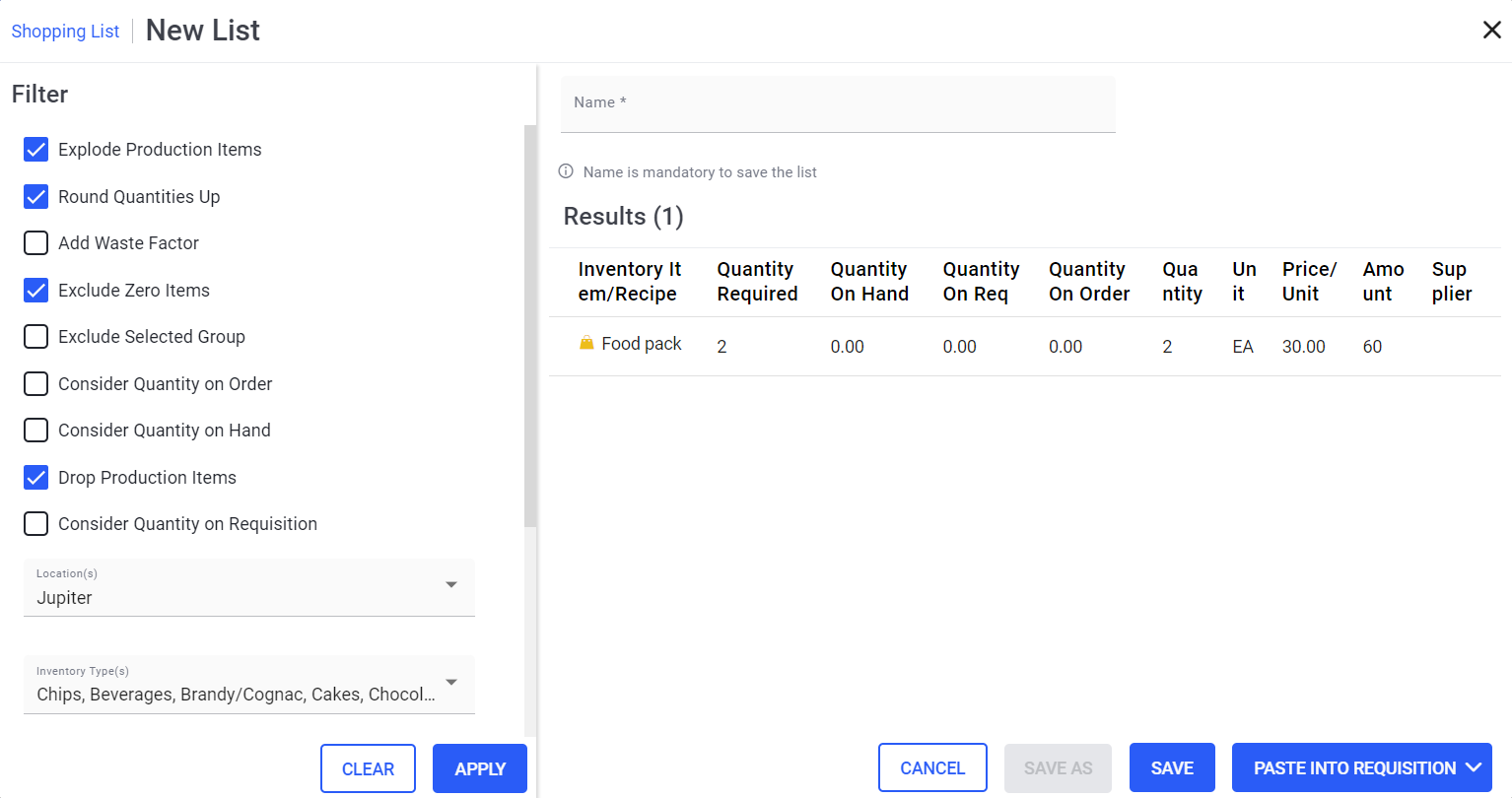
Click Save. The saved information appears in the Saved List section.
Users can also post the inventory item list by selecting any of the following options:
-
Paste into Requisition - directs the user to the Requisitions page when clicked. Items available on the Analysis page must be entered to create a new requisition. Items are converted to transaction units on the Requisitions page. Once the requisition is posted, users are redirected to the Recipe - Analysis page.
-
Paste into Purchase Order - directs the user to the Purchase Order page when clicked. Items available on the Analysis page must be entered to create a new purchase order. Items are converted to transaction units on the Purchase Order page. Once the purchase order is posted, users are redirected to the Recipe - Analysis page.
-
Paste into Receiving - directs the user to the Receiving page when clicked. Items available on the Analysis page must be entered to create a new receiving. Items are converted to transaction units on the Receiving page. Once the receiving is posted, users are redirected to the Recipe - Analysis page.
-
Paste into Purchase Request - directs the user to the Purchase Request page when clicked. Items available on the Analysis page must be entered to create a new purchase request. Items are converted to transaction units on the Purchase Request page. Once the purchase request is posted, users are redirected to the Recipe - Analysis page.
Print Nutrition
Print Nutrition allows users to print the nutrition content of the inventory product. Perform the following steps to print or download the nutrition list for the inventory items:
Click Manage ➜ Print Nutrition. The print layout appears with the nutrition details of the items and a PDF is automatically downloaded.
The following details of the inventory items are displayed under Nutrition:
-
USDA Nutrition Link
-
Product Serving Service/ Nutrition Calculator
-
Label Information
-
Refuse Adjustments
-
Nutrients
Sample Nutrient List

Custom View Option for Ingredients List in Recipes
Users can shuffle or sort and hide or display the columns under the Ingredients List tab for a recipe in the Edit page and View recipe page.
Users must click Shuffle Grid Columns under the Ingredients List tab to sort the column grids.
View Recipe Page

Edit Recipe Page
